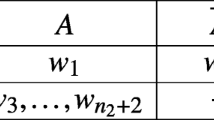Abstract
This article provides a simple decision theoretic model in which elements of the world successively enter the decision maker’s scope and the state space expands over time, which is intended to be the closest correspondence to the standard subjective expected utility theory. We propose a dynamic consistency condition that after any expansion of the scope, the preference ranking should remain unchanged over acts to which the expansion is irrelevant. Together with other natural axioms, it characterizes a model in which the decision maker’s belief extends over time in order that the marginal distribution of the new belief induced over the old state space coincides with the old belief. It is extended to encompass both expansion of scope and learning events, and we characterize the model with an additional property that the decision maker’s belief updating follows Bayes’ rule when she learns events.
Similar content being viewed by others
References
Ahn D., Ergin H. (2010) Framing contingencies. Econometrica 78(2): 655–669
Anscombe F. J., Aumann R. J. (1963) A definition of subjective probability. Annals of Mathematical Statistics 34: 199–205
Board O., & Chung K. (2007). Object-based unawareness, working paper. Minneapolis: University of Minnesota
Dekel E., Lipman B., Rustichini A. (1998) Standard state-space models preclude unawareness. Econometrica 66(1): 159–173
Dekel E., Lipman B., Rustichini A. (1998) Recent developments in modeling unforeseen contingencies. European Economic Review 42(3–5): 523–542
Epstein L., Le Breton M. (1993) Dynamically consistent beliefs must be Bayesian. Journal of Economic Theory 61(1): 1–22
Epstein L., Marinacci M., Seo K. (2007) Coarse contingencies and ambiguity. Theoretical Economics 2: 355–394
Ghirardato P. (2002) Revisiting savage in a conditional world. Economic Theory 20: 83–92
Grant, S., & Quiggin, J. (2007). Awareness and discovery, working paper. Houston: Rice University.
Grant, S., & Quiggin, J. (2008). Bounded rationality and small worlds, working paper. Houston: Rice University.
Heifetz A., Meier M., Schipper B. (2006) Interactive unawareness. Journal of Economic Theory 130(1): 78–94
Karni, E., & Viero, M. (2011). gReverse Bayesianismh: A choice-based theory of growing awareness, working paper. Mimeo: Johns Hopkins University
Kochov, A. (2009). A model of limited foresight, working paper, University of Rochester. Kingston: Queen’s University
Li J. (2009) Information structures with unawareness. Journal of Economic Theory 144: 977–993
Mukerji S. (1997) Understanding the non-additive probability decision model. Economic Theory 9: 23–46
Savage L. (1954) The foundations of statistics. Wiley, New York
Schipper, B. (2010). Revealed unawareness, working paper. Davis: University of California.
Skiadas C. (1997) Conditioning and aggregation of preferences. Econometrica 65(2): 347–367
Torres, R. (2008). State space dimensions and belief updating, working paper. Girona: ITAM, Universitat de Girona.
Author information
Authors and Affiliations
Corresponding author
Rights and permissions
About this article
Cite this article
Hayashi, T. Expanding state space and extension of beliefs. Theory Decis 73, 591–604 (2012). https://doi.org/10.1007/s11238-012-9302-y
Published:
Issue Date:
DOI: https://doi.org/10.1007/s11238-012-9302-y




